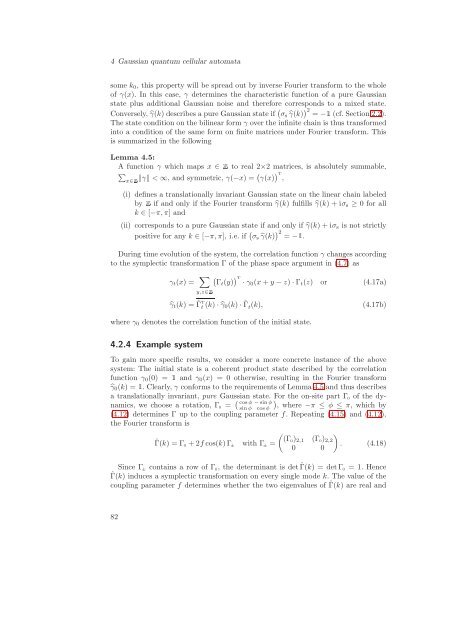Quantum Information Theory with Gaussian Systems
Quantum Information Theory with Gaussian Systems
Quantum Information Theory with Gaussian Systems
Create successful ePaper yourself
Turn your PDF publications into a flip-book with our unique Google optimized e-Paper software.
4 <strong>Gaussian</strong> quantum cellular automata<br />
some k0, this property will be spread out by inverse Fourier transform to the whole<br />
of γ(x). In this case, γ determines the characteristic function of a pure <strong>Gaussian</strong><br />
state plus additional <strong>Gaussian</strong> noise and therefore corresponds to a mixed state.<br />
Conversely, γ(k) describes a pure <strong>Gaussian</strong> state if σs γ(k) 2 = − (cf. Section 2.2).<br />
The state condition on the bilinear form γ over the infinite chain is thus transformed<br />
into a condition of the same form on finite matrices under Fourier transform. This<br />
is summarized in the following<br />
Lemma 4.5:<br />
A function γ which maps x ∈to real 2×2 matrices, is absolutely summable,<br />
<br />
x∈γ < ∞, and symmetric, γ(−x) = γ(x) T<br />
,<br />
(i) defines a translationally invariant <strong>Gaussian</strong> state on the linear chain labeled<br />
byif and only if the Fourier transform γ(k) fulfills γ(k) + iσs ≥ 0 for all<br />
k ∈ [−π, π] and<br />
(ii) corresponds to a pure <strong>Gaussian</strong> state if and only if γ(k) + iσs is not strictly<br />
positive for any k ∈ [−π, π], i.e. if σs γ(k) 2 = − .<br />
During time evolution of the system, the correlation function γ changes according<br />
to the symplectic transformation Γ of the phase space argument in (4.7) as<br />
γt(x) = <br />
Γt(y)<br />
y,z∈ T<br />
· γ0(x + y − z) · Γt(z) or (4.17a)<br />
γt(k) = ˆ Γ T<br />
t (k) · γ0(k) · ˆ Γ t(k), (4.17b)<br />
where γ0 denotes the correlation function of the initial state.<br />
4.2.4 Example system<br />
To gain more specific results, we consider a more concrete instance of the above<br />
system: The initial state is a coherent product state described by the correlation<br />
function γ0(0) = and γ0(x) = 0 otherwise, resulting in the Fourier transform<br />
γ0(k) = . Clearly, γ conforms to the requirements of Lemma 4.5 and thus describes<br />
a translationally invariant, pure <strong>Gaussian</strong> state. For the on-site part Γ0 of the dynamics,<br />
we choose a rotation, Γ0 = cos φ −sin φ <br />
sin φ cos φ , where −π ≤ φ ≤ π, which by<br />
(4.12) determines Γ up to the coupling parameter f. Repeating (4.15) and (4.12),<br />
the Fourier transform is<br />
ˆΓ(k) = Γ 0 + 2f cos(k)Γ ±<br />
<strong>with</strong> Γ ± =<br />
<br />
(Γ0)2,1 (Γ0)2,2 . (4.18)<br />
0 0<br />
Since Γ ± contains a row of Γ 0, the determinant is det ˆ Γ(k) = detΓ 0 = 1. Hence<br />
ˆΓ(k) induces a symplectic transformation on every single mode k. The value of the<br />
coupling parameter f determines whether the two eigenvalues of ˆ Γ(k) are real and<br />
82
















